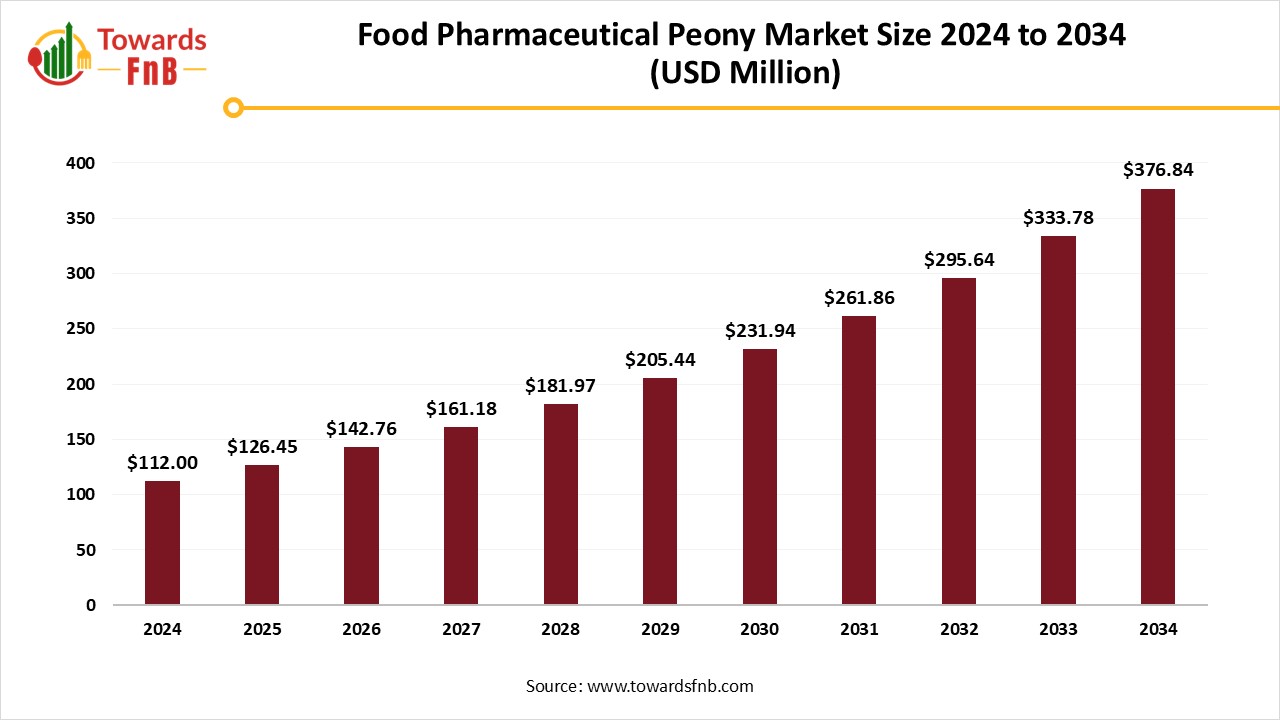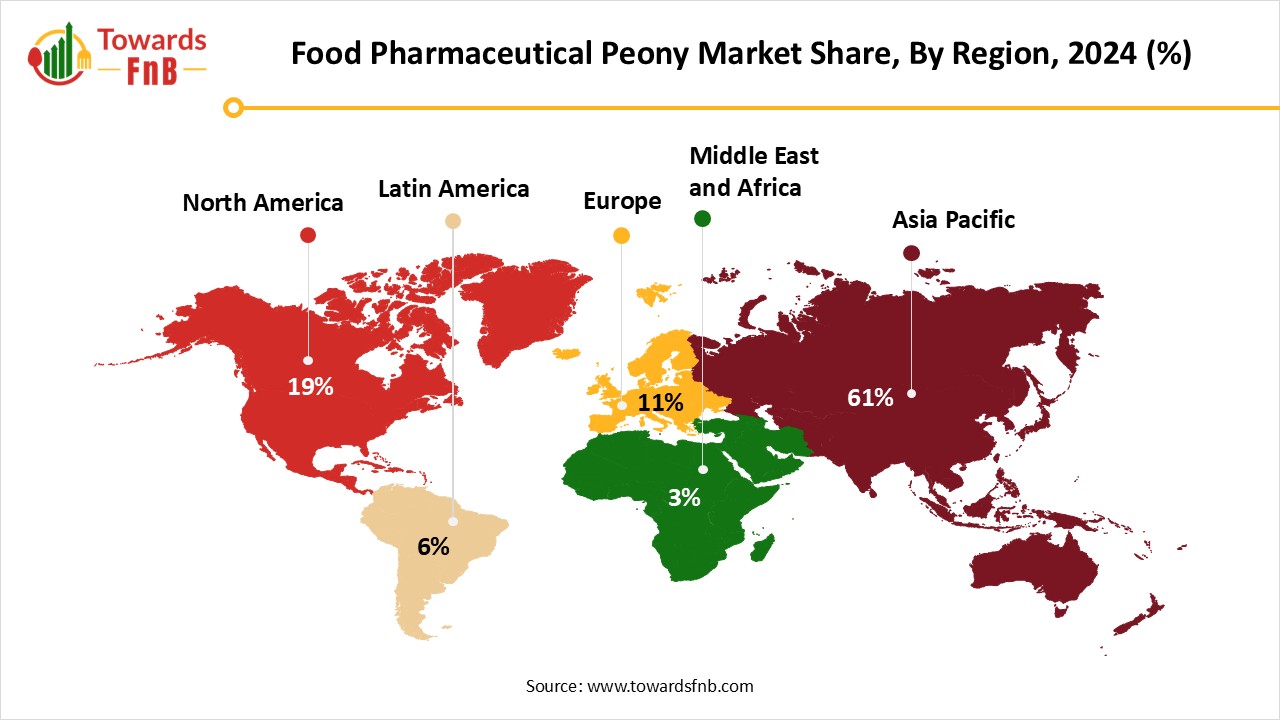December 2025
The global food pharmaceutical peony market size was valued at USD 112 million in 2024 and is predicted to increase from USD 126.45 million in 2025 to approximately USD 376.84 million by 2034, growing at a CAGR of 12.9% during the forecast period 2025 to 2034. Rising demand for the plant-based food and pharmaceuticals, changing consumer preference and technological development significantly driving the market.

| Study Coverage | Details |
| Growth Rate from 2025 to 2034 | CAGR of 12.9% |
| Market Size in 2025 | USD 126.45 Billion |
| Market Size in 2026 | USD 142.76 Billion |
| Market Size by 2034 | USD 376.84 Billion |
| Largest Market | Asia Pacific |
| Base Year | 2024 |
| Forecast Period | 2025 to 2034 |
| Regions Covered | North America, Europe, Asia-Pacific, Latin America, and Middle East & Africa |
The food pharmaceutical peony market refers to the global industry involved in the cultivation, extraction, processing, and commercialization of peony plant derivatives particularly from the roots, seeds, and flowers used in functional food, nutraceuticals, and pharmaceutical applications. Peony (especially Paeonia lactiflora and Paeonia suffruticosa) contains bioactive compounds such as paeoniflorin, flavonoids, and polyphenols, known for their anti-inflammatory, antioxidant, immune-modulating, and neuroprotective properties. The market includes a variety of end uses in herbal medicine, supplements, healthy food, and natural cosmetics.
Rising consumer curiosity about natural components and the expanding recognition of peony's possible health advantages. Crucial sectors for expansion encompass functional foods, dietary supplements, and customized health products, while continuous studies underscore the medicinal benefits of peony. Creative product development, like producing functional foods enriched with peony extracts, offers further possibilities. Continued studies emphasizing the healing capabilities of peony reveal an obvious opportunity for growth and advancement, guaranteeing that this enduring plant remains successful in today's market.
Disruptions in the supply chain, logistical issues, and workforce shortages have hindered peony farming, impacting both quality and volume. Limited worker availability and travel limitations have obstructed harvesting, resulting in production setbacks and higher expenses. Moreover, economic uncertainties have limited consumer expenditure on non-essential goods, impacting the demand for peony-based products in the food and pharmaceutical industries.
Asia Pacific Dominated the Food Pharmaceutical Peony Parket in 2024.
Peony has been historically utilized in Chinese medicine for its inflammation-reducing, oxidative stress-fighting, and immune-enhancing qualities. In Asia, especially in China and Japan, peonies have profound cultural importance and are widely grown for decorative reasons and traditional medicinal applications. This cultural knowledge, along with rising disposable incomes and a trend towards comprehensive health methods, drives the demand for peony-based products. Certain governments in the Asia Pacific area back herbal medicine, thus boosting the usage and need for peony extract.
The market for Chinese food pharmaceutical peony plays a major role worldwide, fueled by robust local demand and a deep-rooted history in traditional medicine. China's market supremacy stems from its vast peony cultivation and well-established methods for producing and using peony root bark extract. The growth of this market is driven by a rising awareness of natural health products and their uses in pharmaceuticals, cosmetics, and dietary supplements.

North America Expects the Significant Growth During the Forecast Period.
The North America food pharmaceutical peony market is highly significant due to the rising requirement for natural and herbal components in the health and wellness sector. The market has gained momentum owing to increased consumer interest in plant-based remedies for a range of health issues, such as anxiety, joint discomfort, and aging skin. As the movement towards plant-based remedies grows, the market is expected to experience consistent expansion in the years ahead, fueled by wellness trends in North America.
An increasing demand for natural health alternatives, such as products derived from peony, is driving market expansion in U.S. The increasing awareness of the therapeutic benefits of peony, including its anti-inflammatory and antioxidant properties, is driving market acceptance. Efforts by the U.S. government to fund and support research in herbal medicine are aiding in the validation of peony for different therapies. The U.S. market plays a crucial role in the worldwide trend towards herbal and natural products, making peony a highly desirable ingredient globally.
Which Product Type Segment Dominated the Food Pharmaceutical Peony Market in 2024?
Peony root extract segment dominated the market with the largest share in 2024. Peony root extract, obtained from the root bark of the peony plant, is well-known for its therapeutic benefits. The extraction method focuses on its bioactive compounds, which have anti-inflammatory, antioxidant, and pain-relieving properties. This extract is a key component in both traditional and herbal medicine, utilized to reduce pain and inflammation linked to arthritis and menstrual discomfort. Peony root extract is widely used in skincare items due to its effectiveness in calming irritated skin and diminishing redness, making it a sought-after ingredient in cosmetic and topical products.
Peony-infused functional food segment is observed to grow at the fastest rate during the forecast period. Increasing health awareness and a preventive healthcare trend, where consumers seek foods offering additional health benefits beyond basic nutrition to manage their well-being proactively. Health-conscious consumers are actively seeking out functional foods with specific health benefits, such as those offered by herbal ingredients.
Which Compound Focus Segment Held the Largest Share of the Food Pharmaceutical Peony Market in 2024?
Paeoniflorin-based products segment held the largest share of the market in 2024. The paeoniflorin-based products segment is a developing area in the herbal and pharmaceutical fields, marked by the increasing acknowledgment of this bioactive compound sourced from peony roots for its multiple health advantages. Paeoniflorin, recognized for its anti-inflammatory, pain-relieving, and neuroprotective effects, has captured interest in both conventional and contemporary medicine. Its uses extend to dietary supplements, beauty products, and medications, targeting various health concerns like persistent pain, anxiety, and dermatological issues. With the movement in healthcare towards natural and plant-derived options, the need for Paeoniflorin is anticipated to increase, providing various advantages while addressing the growing consumer inclination for holistic health solutions.
Flavonoid & Polyphenol Extracts Segment is Seen to Grow at a Notable Rate During the Predicted Timeframe.
Increasing consumer demand for natural and plant-derived products for disease prevention and general health is a significant influence. Polyphenols are progressively being added to functional foods and drinks to improve their nutritional benefits and attractiveness. The interest in polyphenol-rich supplements is increasing, as people aim to tackle particular health issues or boost their daily nutrient consumption. The pharmaceutical and nutraceutical sectors are progressively utilizing plant flavonoids due to their potential health advantages. Consequently, the rising consumer demand for nutraceuticals is propelling the segment.
Why Did the Nutraceuticals & Supplements Segment Dominate the Food Pharmaceutical Peony Market in 2024?
Nutraceuticals & supplements segment led the food pharmaceutical peony market in 2024. Increasing need for nutrient-dense foods driven by busy lifestyles and heightened consumer knowledge of the health benefits of these products is anticipated to propel market expansion. Additionally, throughout the COVID-19 pandemic, a growingly anxious population turned to numerous nutraceuticals and supplements items that claimed to enhance immunity or offer protection against diseases. Such a trend is expected to drive the market in the years ahead. The worldwide nutraceuticals and supplements provide products for various application areas such as sports nutrition, clinical nutrition, weight management, heart health, immunity, and digestive health. Peony seeds and even leaves are being investigated for their nutritional and therapeutic benefits, presenting multiple possibilities for nutraceuticals and supplements developments.
Skincare & Natural Cosmetics Segment is Expected to Grow at the Fastest Rate in the Market During the Forecast Period.
The need for skin nutrition products has increased due to growing concerns about skin care caused by a variety of problems, including dark spots, acne, scars, lack of radiance, and tanning. Younger people are becoming more and more interested in skin-brightening creams, toners, and scrubs. On the other hand, because older people are becoming more demanding, the market for products that treat wrinkles or damaged heels is expanding significantly. Because of their potent anti-inflammatory, hydrating, and antioxidant properties, peony extracts particularly those from the white peony are becoming more and more popular in skincare and cosmetics products. They reduce wrinkles, soothe sensitive skin, and improve skin tone.
Which End User Segment Held the Dominating Share of the Food Pharmaceutical Peony Market in 2024?
Pharmaceuticals segment held the dominating share of the food pharmaceutical peony market in 2024. Peony has been historically utilized in Chinese medicine for its properties that reduce inflammation, combat oxidation, and enhance immune function. This has resulted in a greater integration of peony extracts into different pharmaceutical formulations and nutraceutical products. Moreover, the increasing prevalence of chronic illnesses and the worldwide aging demographic are fueling the need for natural and effective treatment options, which further supports market expansion.
Food and Beverage Segment is Observed to Grow at the Fastest CAGR During the Forecast Period.
The worldwide trend towards health and wellness is another significant factor propelling the food and beverages industry. Shoppers are progressively focusing on items that support a healthier way of living, such as organic, plant-derived, and clean-label food choices. Furthermore, the growth of e-commerce provides a major chance for brands to connect with consumers directly, delivering tailored shopping experiences that accommodate personal dietary needs and limitations. Peony completes the consumer demand for the healthy and functional food and boosts the market.
Which Distribution Channel Dominated the Food Pharmaceutical Peony Market with the Largest Share in 2024?
Pharmacies & herbal retailers segment led the market with the largest share in 2024. Pharmacies and herbal stores remain an essential distribution channel, particularly for peony products utilized in dietary supplements and medications. The trust and reliability linked to buying health products from pharmacies strengthen their market standing. Customers frequently depend on pharmacists' knowledge to assist them in choosing suitable products, highlighting the significance of this avenue.
Online & Direct-to-consumer (DTC) Channels are Seen to Grow at a Notable Rate During the Predicted Timeframe.
The online and direct-to-consumer (DTC) channel is an expanding pathway for the food pharmaceutical peony sector, providing enhanced accessibility and direct interaction with customers. This method enables businesses to avoid conventional intermediaries, which may reduce expenses and increase profits while also improving the customer experience. The online retail sector represents a crucial aspect of the DTC channel, enabling consumers to buy peony-based items straight from brand websites, online marketplaces, or dedicated e-commerce platforms.
Peking University
Ichimaru Pharcos

By Product Type
By Compound Focus
By Application
By End-User Industry
By Distribution Channel
By Region
December 2025
November 2025
November 2025
November 2025